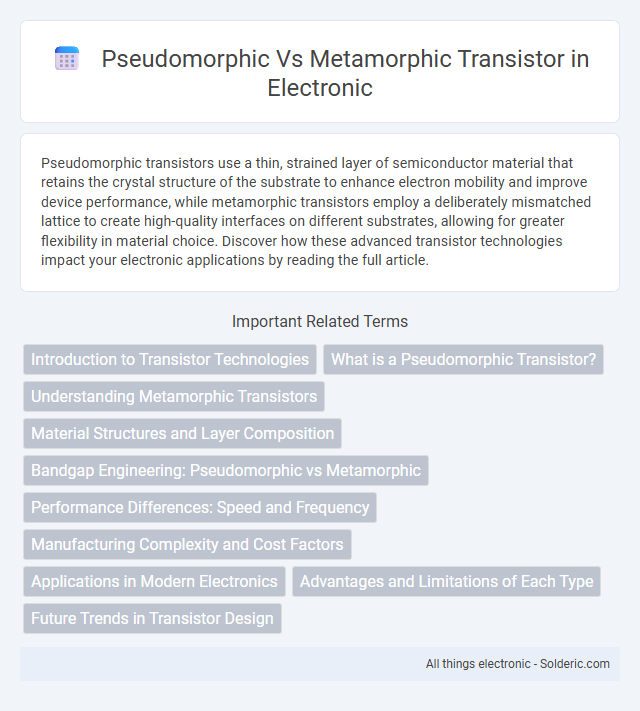Pseudomorphic transistors use a thin, strained layer of semiconductor material that retains the crystal structure of the substrate to enhance electron mobility and improve device performance, while metamorphic transistors employ a deliberately mismatched lattice to create high-quality interfaces on different substrates, allowing for greater flexibility in material choice. Discover how these advanced transistor technologies impact your electronic applications by reading the full article.
Comparison Table
| Feature | Pseudomorphic Transistor | Metamorphic Transistor |
|---|---|---|
| Definition | Transistor with strained layer grown on a substrate with different lattice constant | Transistor grown on a substrate with a different lattice constant without strain relief |
| Material System | Typically InGaAs on GaAs substrate | Typically InGaAs on InP or GaAs on Si substrate |
| Strain | Strained layer within critical thickness preserving crystal quality | Relaxed or semi-relaxed layer with dislocations |
| Electron Mobility | High electron mobility due to strain | Moderate electron mobility due to relaxation defects |
| Performance | Excellent high-frequency and low-noise performance | Good performance with larger device scalability |
| Applications | High-speed RF and microwave circuits | Power amplifiers and monolithic microwave integrated circuits (MMICs) |
| Growth Complexity | Requires precise control to maintain strain | Allows thicker layers, easier growth control |
Introduction to Transistor Technologies
Pseudomorphic transistors utilize a thin epitaxial layer with a lattice structure slightly mismatched to the substrate, enhancing electron mobility and device performance in high-frequency applications. Metamorphic transistors employ a relaxed buffer layer to accommodate larger lattice mismatches, enabling the integration of materials with superior electronic properties for improved power efficiency and speed. Both technologies advance transistor capabilities by optimizing bandgap engineering and strain effects for tailored semiconductor device characteristics.
What is a Pseudomorphic Transistor?
A Pseudomorphic Transistor utilizes a strained layer of semiconductor material, such as InGaAs on a GaAs substrate, to achieve superior electron mobility and higher speed than conventional transistors. This strain engineering allows the transistor to maintain lattice matching while enhancing device performance, especially in high-frequency and high-speed applications. Your choice of a pseudomorphic transistor can significantly improve the efficiency and speed of advanced electronic circuits.
Understanding Metamorphic Transistors
Metamorphic transistors employ a mismatched lattice structure on the substrate, allowing for tailored bandgap engineering and enhanced electron mobility compared to pseudomorphic transistors, which rely on strained layers with matched lattice constants. These transistors are essential for high-frequency and high-speed applications due to their superior carrier transport properties. Understanding metamorphic transistors helps you leverage their advantages in designing advanced semiconductor devices with improved performance metrics.
Material Structures and Layer Composition
Pseudomorphic transistors utilize strained epitaxial layers grown on substrates with a slightly different lattice constant, leading to enhanced electron mobility by preserving crystal structure continuity. Metamorphic transistors, on the other hand, incorporate buffer layers that gradually transition lattice constants to accommodate mismatched materials, enabling the use of diverse semiconductor compounds like InGaAs on GaAs substrates. Your choice between these transistors influences device performance through variations in material strain, defect density, and layer composition tailored for high-speed and high-frequency applications.
Bandgap Engineering: Pseudomorphic vs Metamorphic
Pseudomorphic transistors exploit lattice-matched heterostructures to achieve precise bandgap engineering, resulting in reduced defects and enhanced carrier mobility by maintaining strain within critical limits. Metamorphic transistors utilize relaxed buffer layers to accommodate lattice mismatches, enabling wider bandgap tuning but often at the cost of increased dislocation densities and reduced material quality. The choice between pseudomorphic and metamorphic designs balances trade-offs between strain-induced performance benefits and defect-related limitations in bandgap engineering.
Performance Differences: Speed and Frequency
Pseudomorphic transistors exhibit higher electron mobility due to strain-engineered channels, resulting in superior speed and enhanced high-frequency performance compared to metamorphic transistors. Metamorphic transistors, while flexible in material integration, typically demonstrate lower cutoff frequencies due to increased defect densities impacting carrier transport. The strain-induced improvements in pseudomorphic devices enable operation at gigahertz frequencies, making them ideal for high-speed, high-frequency applications like RF amplifiers and high-speed digital circuits.
Manufacturing Complexity and Cost Factors
Pseudomorphic transistors involve a lattice-mismatched epitaxial layer grown on a substrate, requiring advanced molecular beam epitaxy or metal-organic chemical vapor deposition techniques, which increase manufacturing complexity and cost. Metamorphic transistors use buffer layers to gradually change lattice constants, simplifying substrate compatibility but adding intricate strain management steps that impact overall fabrication expenses. Your choice between these devices will affect production scalability and budget due to differences in epitaxial growth precision and substrate requirements.
Applications in Modern Electronics
Pseudomorphic transistors are extensively used in high-frequency and microwave applications due to their superior electron mobility and performance in heterostructure field-effect transistors (HFETs). Metamorphic transistors excel in power amplifiers for telecommunications and radar systems, benefiting from their ability to integrate different lattice materials for optimized bandgap engineering. Both technologies play crucial roles in enhancing the efficiency and speed of modern semiconductor devices in wireless communication and satellite technology.
Advantages and Limitations of Each Type
Pseudomorphic transistors offer high electron mobility due to strained epitaxial layers, resulting in superior high-frequency performance and lower noise, but their fabrication complexity and sensitivity to defects limit yield and increase cost. Metamorphic transistors allow integration of lattice-mismatched materials for bandgap engineering and enhanced scalability, yet they may suffer from higher defect densities and reduced reliability compared to pseudomorphic devices. Both types provide critical advantages for high-speed and high-power applications, with trade-offs in manufacturing challenges and long-term device stability.
Future Trends in Transistor Design
Pseudomorphic transistors leverage strained semiconductor layers to enhance electron mobility, enabling higher-speed and lower-power devices critical for next-generation 5G and AI applications. Metamorphic transistors offer flexibility by integrating diverse material systems with tailored bandgaps, driving advancements in high-frequency and high-power electronics for future telecommunications and defense technologies. Your choice of transistor design directly impacts performance optimization in emerging applications demanding ultra-fast processing and energy efficiency.
Pseudomorphic vs Metamorphic transistor Infographic

 solderic.com
solderic.com